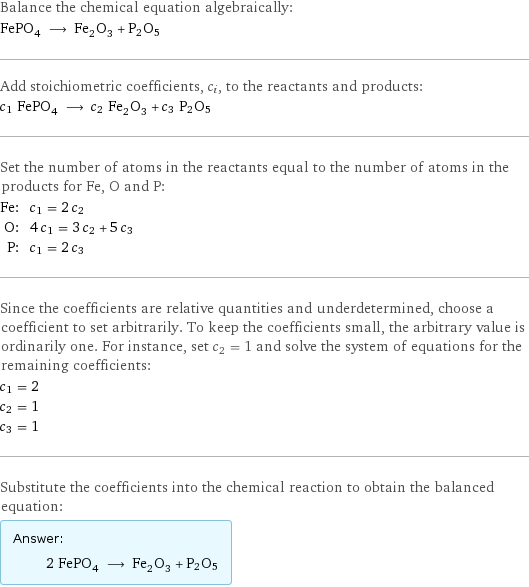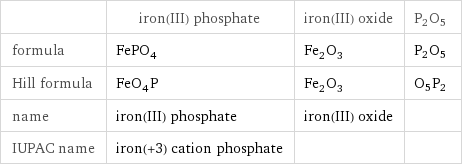Input interpretation

FePO_4 iron(III) phosphate ⟶ Fe_2O_3 iron(III) oxide + P2O5
Balanced equation

Balance the chemical equation algebraically: FePO_4 ⟶ Fe_2O_3 + P2O5 Add stoichiometric coefficients, c_i, to the reactants and products: c_1 FePO_4 ⟶ c_2 Fe_2O_3 + c_3 P2O5 Set the number of atoms in the reactants equal to the number of atoms in the products for Fe, O and P: Fe: | c_1 = 2 c_2 O: | 4 c_1 = 3 c_2 + 5 c_3 P: | c_1 = 2 c_3 Since the coefficients are relative quantities and underdetermined, choose a coefficient to set arbitrarily. To keep the coefficients small, the arbitrary value is ordinarily one. For instance, set c_2 = 1 and solve the system of equations for the remaining coefficients: c_1 = 2 c_2 = 1 c_3 = 1 Substitute the coefficients into the chemical reaction to obtain the balanced equation: Answer: | | 2 FePO_4 ⟶ Fe_2O_3 + P2O5
Structures

⟶ + P2O5
Names

iron(III) phosphate ⟶ iron(III) oxide + P2O5
Equilibrium constant
![Construct the equilibrium constant, K, expression for: FePO_4 ⟶ Fe_2O_3 + P2O5 Plan: • Balance the chemical equation. • Determine the stoichiometric numbers. • Assemble the activity expression for each chemical species. • Use the activity expressions to build the equilibrium constant expression. Write the balanced chemical equation: 2 FePO_4 ⟶ Fe_2O_3 + P2O5 Assign stoichiometric numbers, ν_i, using the stoichiometric coefficients, c_i, from the balanced chemical equation in the following manner: ν_i = -c_i for reactants and ν_i = c_i for products: chemical species | c_i | ν_i FePO_4 | 2 | -2 Fe_2O_3 | 1 | 1 P2O5 | 1 | 1 Assemble the activity expressions accounting for the state of matter and ν_i: chemical species | c_i | ν_i | activity expression FePO_4 | 2 | -2 | ([FePO4])^(-2) Fe_2O_3 | 1 | 1 | [Fe2O3] P2O5 | 1 | 1 | [P2O5] The equilibrium constant symbol in the concentration basis is: K_c Mulitply the activity expressions to arrive at the K_c expression: Answer: | | K_c = ([FePO4])^(-2) [Fe2O3] [P2O5] = ([Fe2O3] [P2O5])/([FePO4])^2](../image_source/56589d981941aa7a35f1dad61648daac.png)
Construct the equilibrium constant, K, expression for: FePO_4 ⟶ Fe_2O_3 + P2O5 Plan: • Balance the chemical equation. • Determine the stoichiometric numbers. • Assemble the activity expression for each chemical species. • Use the activity expressions to build the equilibrium constant expression. Write the balanced chemical equation: 2 FePO_4 ⟶ Fe_2O_3 + P2O5 Assign stoichiometric numbers, ν_i, using the stoichiometric coefficients, c_i, from the balanced chemical equation in the following manner: ν_i = -c_i for reactants and ν_i = c_i for products: chemical species | c_i | ν_i FePO_4 | 2 | -2 Fe_2O_3 | 1 | 1 P2O5 | 1 | 1 Assemble the activity expressions accounting for the state of matter and ν_i: chemical species | c_i | ν_i | activity expression FePO_4 | 2 | -2 | ([FePO4])^(-2) Fe_2O_3 | 1 | 1 | [Fe2O3] P2O5 | 1 | 1 | [P2O5] The equilibrium constant symbol in the concentration basis is: K_c Mulitply the activity expressions to arrive at the K_c expression: Answer: | | K_c = ([FePO4])^(-2) [Fe2O3] [P2O5] = ([Fe2O3] [P2O5])/([FePO4])^2
Rate of reaction
![Construct the rate of reaction expression for: FePO_4 ⟶ Fe_2O_3 + P2O5 Plan: • Balance the chemical equation. • Determine the stoichiometric numbers. • Assemble the rate term for each chemical species. • Write the rate of reaction expression. Write the balanced chemical equation: 2 FePO_4 ⟶ Fe_2O_3 + P2O5 Assign stoichiometric numbers, ν_i, using the stoichiometric coefficients, c_i, from the balanced chemical equation in the following manner: ν_i = -c_i for reactants and ν_i = c_i for products: chemical species | c_i | ν_i FePO_4 | 2 | -2 Fe_2O_3 | 1 | 1 P2O5 | 1 | 1 The rate term for each chemical species, B_i, is 1/ν_i(Δ[B_i])/(Δt) where [B_i] is the amount concentration and t is time: chemical species | c_i | ν_i | rate term FePO_4 | 2 | -2 | -1/2 (Δ[FePO4])/(Δt) Fe_2O_3 | 1 | 1 | (Δ[Fe2O3])/(Δt) P2O5 | 1 | 1 | (Δ[P2O5])/(Δt) (for infinitesimal rate of change, replace Δ with d) Set the rate terms equal to each other to arrive at the rate expression: Answer: | | rate = -1/2 (Δ[FePO4])/(Δt) = (Δ[Fe2O3])/(Δt) = (Δ[P2O5])/(Δt) (assuming constant volume and no accumulation of intermediates or side products)](../image_source/e80af7ef0fb24c269fe385efa187cbd2.png)
Construct the rate of reaction expression for: FePO_4 ⟶ Fe_2O_3 + P2O5 Plan: • Balance the chemical equation. • Determine the stoichiometric numbers. • Assemble the rate term for each chemical species. • Write the rate of reaction expression. Write the balanced chemical equation: 2 FePO_4 ⟶ Fe_2O_3 + P2O5 Assign stoichiometric numbers, ν_i, using the stoichiometric coefficients, c_i, from the balanced chemical equation in the following manner: ν_i = -c_i for reactants and ν_i = c_i for products: chemical species | c_i | ν_i FePO_4 | 2 | -2 Fe_2O_3 | 1 | 1 P2O5 | 1 | 1 The rate term for each chemical species, B_i, is 1/ν_i(Δ[B_i])/(Δt) where [B_i] is the amount concentration and t is time: chemical species | c_i | ν_i | rate term FePO_4 | 2 | -2 | -1/2 (Δ[FePO4])/(Δt) Fe_2O_3 | 1 | 1 | (Δ[Fe2O3])/(Δt) P2O5 | 1 | 1 | (Δ[P2O5])/(Δt) (for infinitesimal rate of change, replace Δ with d) Set the rate terms equal to each other to arrive at the rate expression: Answer: | | rate = -1/2 (Δ[FePO4])/(Δt) = (Δ[Fe2O3])/(Δt) = (Δ[P2O5])/(Δt) (assuming constant volume and no accumulation of intermediates or side products)
Chemical names and formulas

| iron(III) phosphate | iron(III) oxide | P2O5 formula | FePO_4 | Fe_2O_3 | P2O5 Hill formula | FeO_4P | Fe_2O_3 | O5P2 name | iron(III) phosphate | iron(III) oxide | IUPAC name | iron(+3) cation phosphate | |
Substance properties

| iron(III) phosphate | iron(III) oxide | P2O5 molar mass | 150.81 g/mol | 159.69 g/mol | 141.94 g/mol phase | | solid (at STP) | melting point | | 1565 °C | density | 2.87 g/cm^3 | 5.26 g/cm^3 | solubility in water | | insoluble | odor | | odorless |
Units
